Appearition Platform
The Appearition Platform is a service that gives you the tools to integrate immersive experiences (AR, VR, MR) into your new or existing apps and solutions. It gives you the control to configure and connect to existing digital content libraries and existing data stores. The platform helps you to aggregate, transform and visualise information for more engaging and contextually relevant presentations and workflows for your end users.
Single Server on AMI with Cloudformation#
All components required by the Appearition Platform are deployed on the one single server. You have access to activate all the modules of the Appearition Platform to enable you to build and integrate immersive experiences within your organisation and business workflows. It is worth noting that the best way to explore the product is to actually build a PoC or prototype. Our team at Appearition have been working closely with customers across different sectors since 2012. We have helped countless companies understand and realise how immersive tech can benefit their organisation. For more information please visit our website or contact us at info@appearition.com to help you on your journey.
Find me in the AWS Marketplace
Start your 30 day free trial: AWS Marketplace - Appearition
Product Video#
Cloudformation Template#
The Single Server version is an AMI which is launched and configured through a Cloudformation Template. The following diagram shows the resources that are launched in your AWS account.

Cost Calculator#
The following link will provide you with an estimate of resource cost for the default installation.
Additional AWS resource information#
For the AMI:#
Location of all sensitive information saved by customers
The Appearition Platform has an inbuilt identity management feature. Information such as a username, password, email address, name, contact details, along with other properties can be collected and stored. All identity information is held in the master database stored on the local MS SQL Server Express database
Explain all data encryption configuration
User accounts are protected by username and password. The password is one way encrypted and stored in a table in the master tenancy database. When a module is activated for a tenant, any sensitive module setting is encrypted and stored in the tenant specific database on the local MS SQL Server Express.
Step-by-step instructions for rotating programmatic system credentials and cryptographic keys. The AMI-based product requirements explain the basic requirements for listings that use credentials and cryptographic keys.
User account passwords can be changed anytime once logged in via the My Profile page. As part of the AMI launch process, an account is automatically created for the System Administrator. The password is set as the instance ID of the EC2 instance. Once logged in, you can change that password via the MyProfile page.
**Provide detailed instructions on how the user interacts with your application to decrypt necessary data if your application makes use of any encryption techniques **
User’s will not interact with encrypted data. Some modules which are activated in a tenant may require an encrypted setting to be configured. In these cases, the system administrator would enter the value once and the system would encrypt and store and then internally decrypt and use as needed.
Step-by-step instructions for how to assess and monitor the health and proper function of the application
-
Verify the EC2 instance is running: - Navigate to your Amazon EC2 console and verify that you’re in the correct region. - Choose Instance and select your launched instance. - Ensure the Instance State is showing running. If not, you will need to start the instance. - If running, choose the Status checks tab at the bottom of the page to review if your status checks passed or failed.
-
Verify the Appearition Platform is running by navigating with a web browser to the portal login page via http://
/login. If it fails to load, check if the public IP address of the EC2 instance has changed from the time you launched the CloudFormation Stack. - Navigate to your Amazon CloudFormation console and verify you’re in the correct region. - Select the Stack created during the initial launch and choose the Output tab. - The login URL printed will contain the original public IP address of the EC2 instance when the stack was first created. If different, you will need to re-run Appearition Platform installation script on the EC2 instance. Please follow the instructions here -
You can find more troubleshooting information here
For the Cloud Formation Template:#
A purpose for each AWS Identity and Access Management (IAM) role and IAM policy created by the AWS CloudFormation template
The CloudFormation template does not create any IAM records.
A purpose and location of each key created by the AWS CloudFormation template
The CloudFormation template does not create any keys.
Network configuration details in deployments involving more than a single element The CloudFormation template will create one EC2 instance in your existing VPC in the region. It also creates a new Security Group in that VPC in the region for the new EC2 instance.
A detailed guide on how your applications are launched and how they’re configured to communicate if the deployment includes multiple AWS resources
All of the components required by the Appearition Platform are installed and configured on the one EC2 instance. No other AWS resources are required.
A pricing breakdown that includes the cost of running AWS resources added above the standard limits. Provide prescriptive guidance on managing AWS service limits.
The Appearition Platforms handles and serves standard HTTP traffic. The EC2 instance therefore does not require any non-standard limits
All data encryption configuration. For example: Amazon S3 server-side encryption, Amazon Elastic Block Store (Amazon EBS) encryption, Linux Unified Key Setup (LUKS), etc.
There is no encryption configuration required by the single EC2 instance.
Deployment Guide#
Please follow these steps to install in your AWS Account:
- Navigate to the region you want to launch into.
- Navigate to AWS CloudFormation
- Click Create Stack and then select With new resources (standard)
- In the Prerequisite - Prepare template panel select Template is ready

- You will need to download the CloudFormation YAML template file (see above)
- In the Specify template panel, select Upload a template file and choose the downloaded file
- Once chosen, it will be uploaded into an S3 bucket the AWS automatically creates

- Click Next
- You will need to enter a Stack name, e.g. AppearitionPlatformSingleServerStack
 and set Parameters:
and set Parameters:- InstanceType: This is the type of instance that will be launched. You can choose from the list of options however the default is the minimum that is recommended
- KeyName: This is the AWS Key Pair for the region for the new AWS account. You will need to pre-create this. This will be used later on to get the Windows Password of the new EC2 instance
- RdpLocation: This is your public IP address which will be added to the AWS security group when created to allow you to RDP into the new instance. (e.g. 111.222.333.444/32). You can discover you public IP address by opening up a Chrome web browser and search for What’s my IP
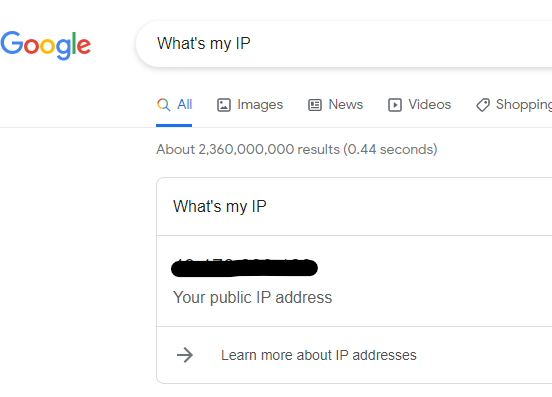
- Click Next
- You can leave this next screen with default value (i.e. Configure stack options) and click Next
- In the Review AppearitionPlatformSingleServerStack screen, scroll to the bottom and click Submit
- AWS CloudFormation will go off and create a number of resources, EC2 instance with an Elastic IP and a Security Group which allows HTTP traffic and RDP access. It will take a few minutes to complete so watch the Event tab.

Grab a coffee
It will take approx 20 mins for the creation to complete. You will find that the “WaitConditionForPlatformInstall” will stay in “CREATE_IN_PROGRESS“ for around 20 mins while the Appearition Platform is being installed, configured and warmed up.

- Once completed, the Outputs panel will list the AppearitionPlatformEc2InstanceId, AppearitionPlatformPublicIP and LoginUrl values.
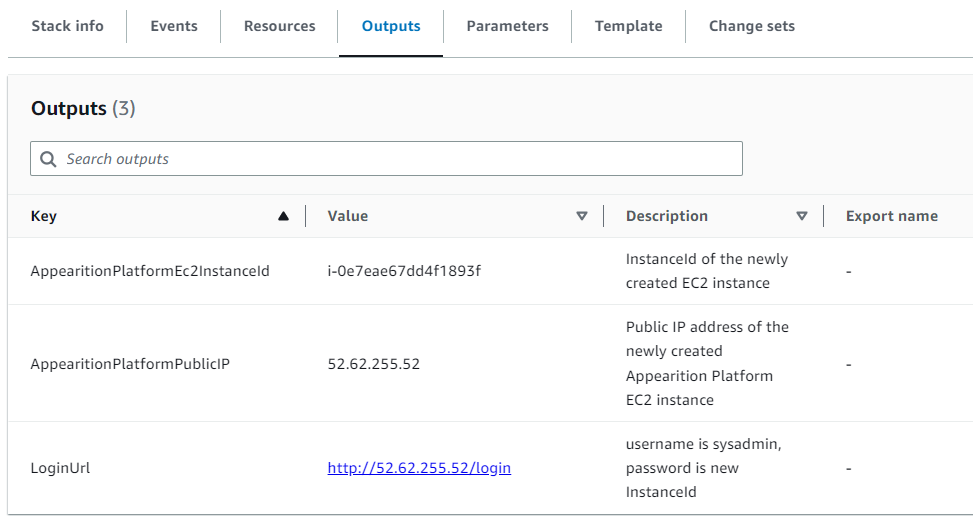
- Click on the LoginUrl link.
- Username sysadmin
- Password is the value of AppearitionPlatformEc2InstanceId
Login to the Appearition Platform#
To login to the Appearition Platform, navigate to http://[Public IP Address of EC2 instance]/login. Username is sysadmin and password is the instance id. Details can be found in the output tab of the cloudformation stack
WebAR Sample#
The Appearition Platform comes with a sample WebAR experience that you can run and try. To access the experience follow these steps:
- Log into portal (refer to the LoginUrl output in the Cloudformation stack)
- username is sysadmin
- password is the instance id of the EC2 instance (refer to the AppearitionPlatformEc2InstanceId output in the Cloudformation stack)
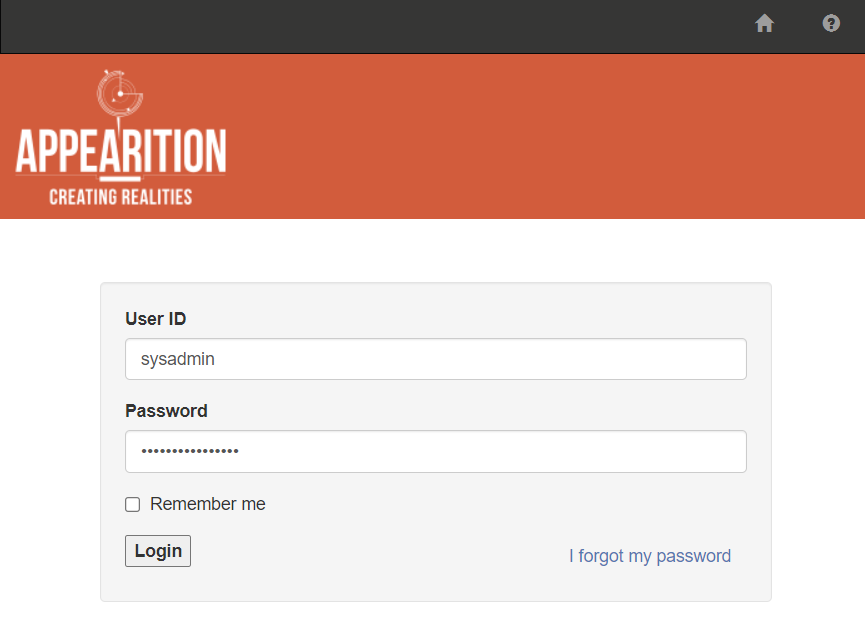
- Select WebAR Samples tenant
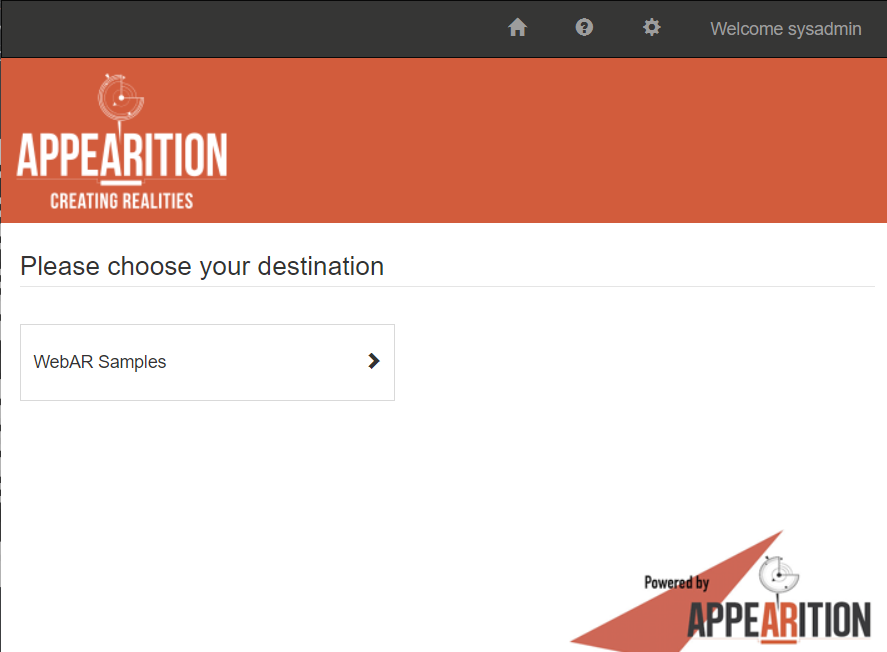
- Click on Your Channel List button

- Click on the Samples channel
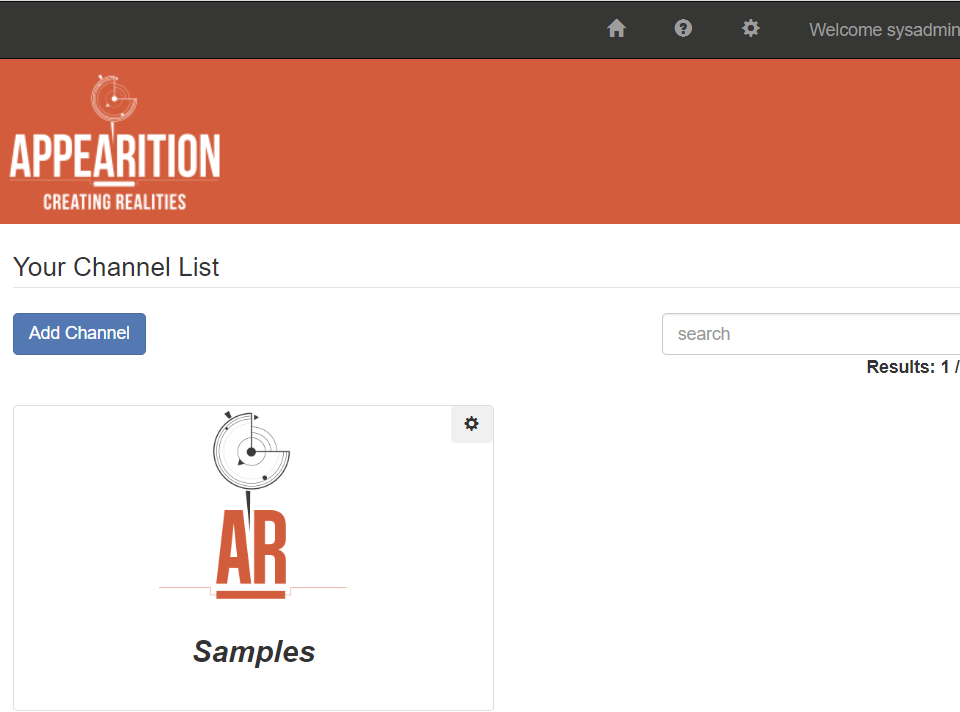
- Click on AR Experience module
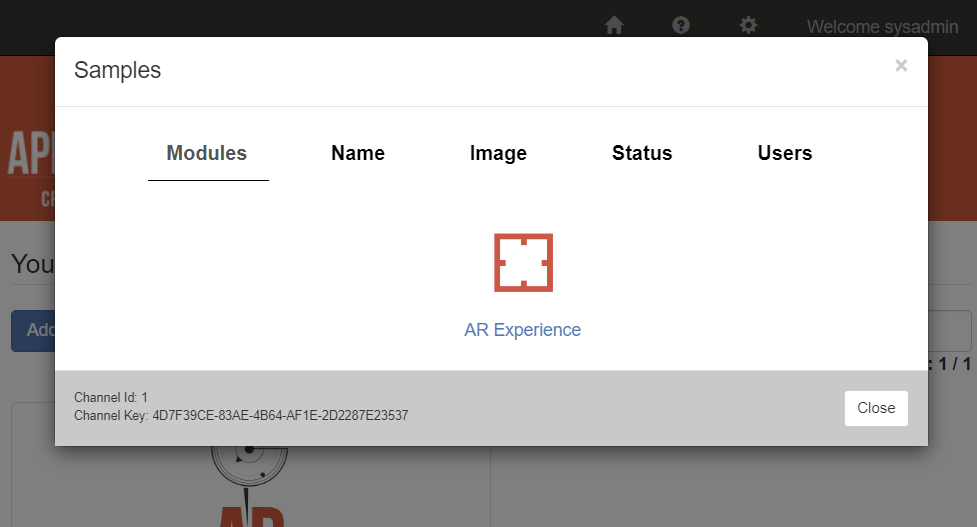
- Click on the first AR record Appearition Logo in 3D

- Click on Status tab
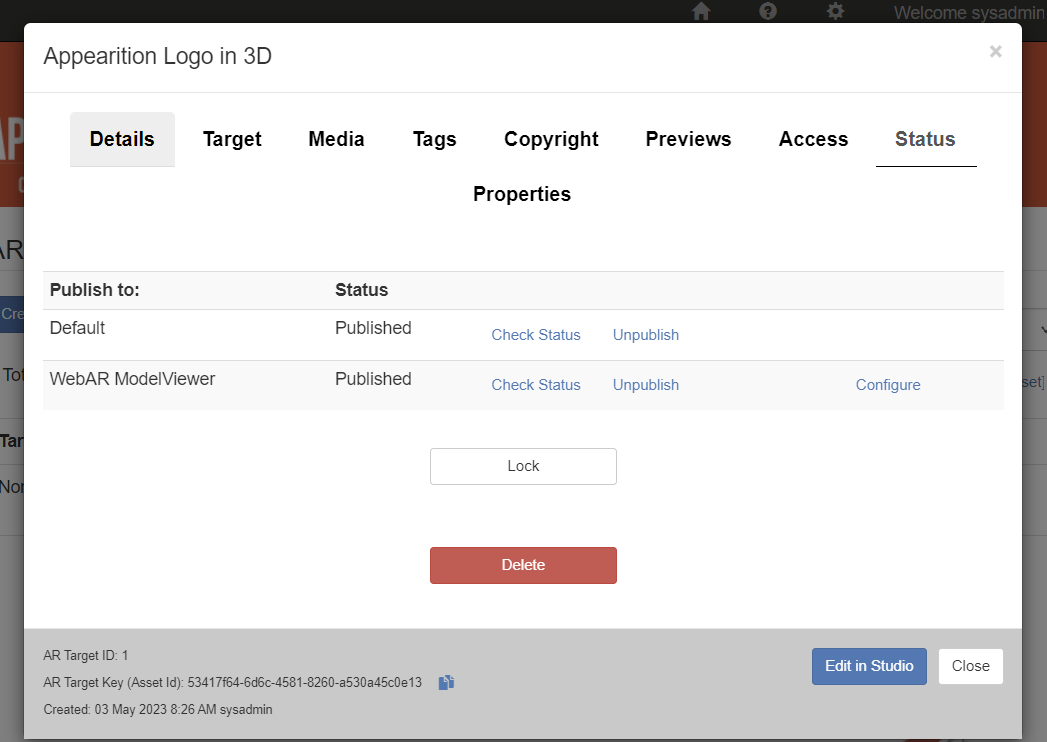
- Click configure link next to the Publish to ModelViewer row

- Scan QR code with your mobile device (iOS or Android)
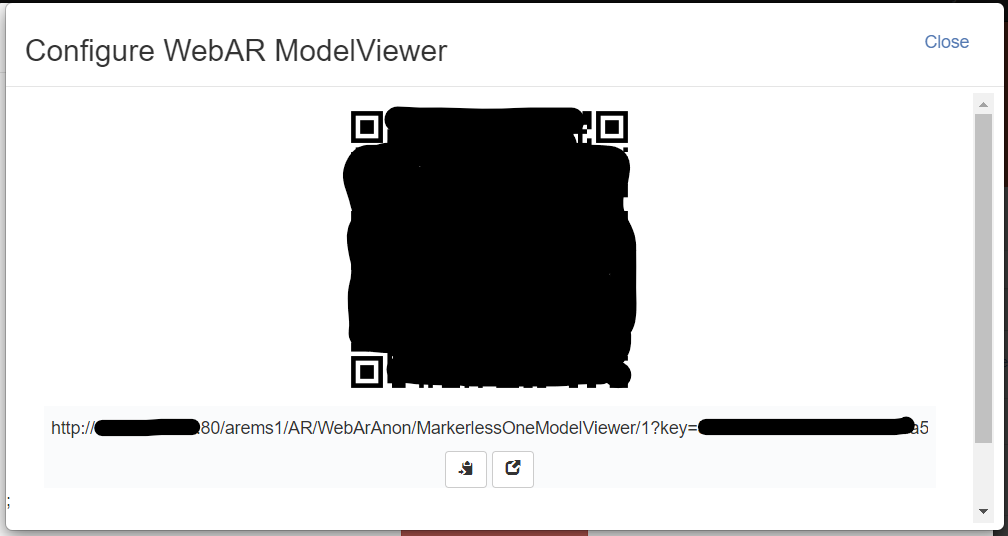

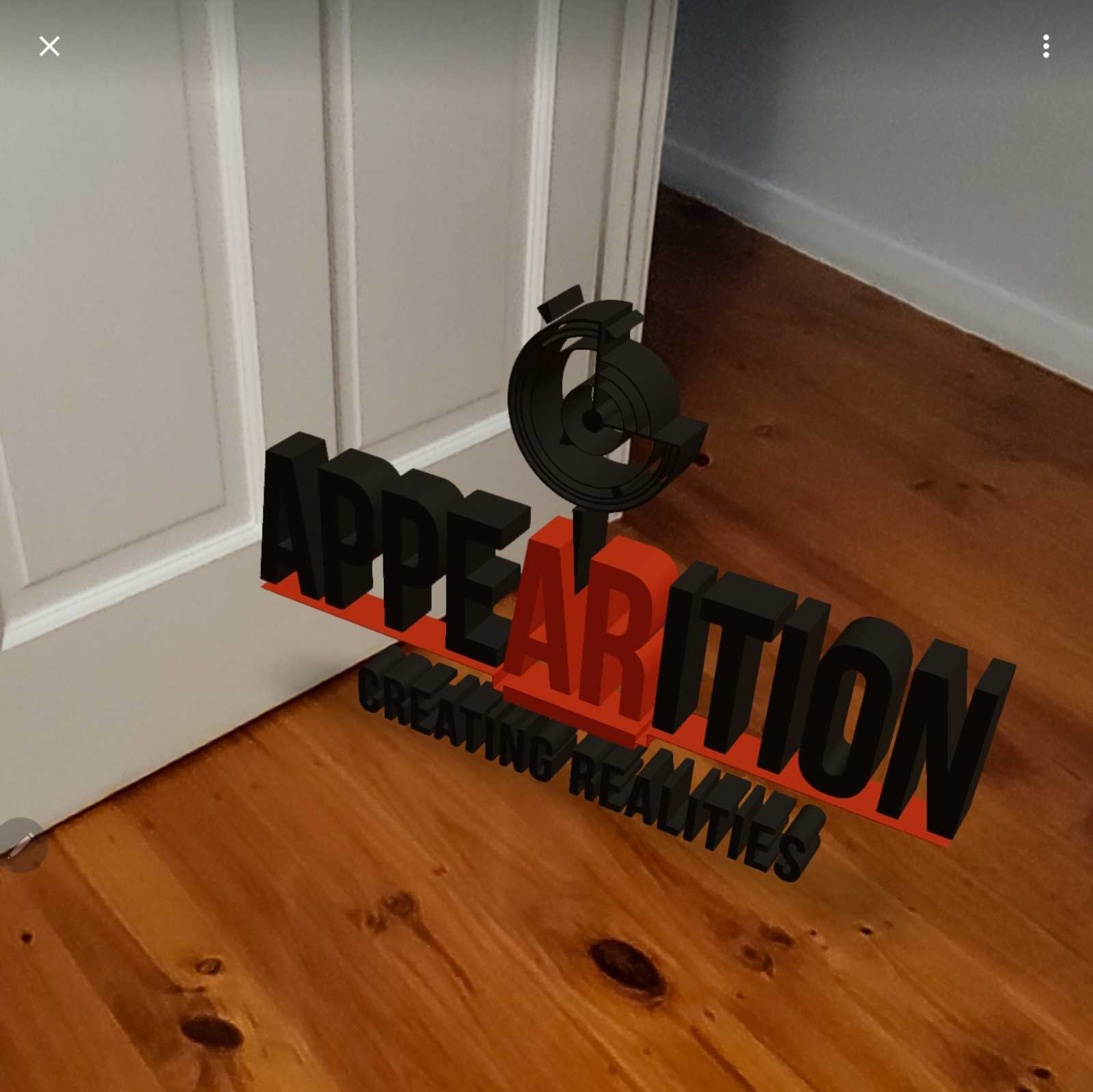
Setting up Domain and SSL#
You can configure you the Appearition Platform to serve content over HTTPS
Prerequisites#
- You need to supply your own domain and subdomain
Domains and Subdomains
You can choose to run the Appearition Platform under a single subdomain and simply have 3 ports for each of the portal, api and cdn Web Apps.
Alternatively (recommended), you can have a separate subdomain for each of the web apps.
For example:
- appearitionportal.mydomain.com
- appearitionapi.mydomain.com
- appearitioncdn.mydomain.com
- You will need access to your DNS records to create an A record that points your subdomain(s) to the IP address of the EC2 instance
- You need to supply your own TLS certificate in PFX format that covers the domain and subdomain(s)
- Your PFX needs a password
- Key Pair file you chose during Cloudformation Stack creation
- Add an ElasticIP to your EC2 instance to ensure a static Public IP address
Steps#
- RDP into Windows Server.
- From the Cloudformation Stack resources, navigate to the new EC2 instance
- Under Actions / Security select “Get Windows Password”
- You will need the KeyPair you selected during Cloudformation Stack creation
- Get Windows username and password and then with the Public IP address of your EC2 instance, you can connect via Remote Desktop Connection (read more).
Check your IP
Make sure you attempt the RDC from the IP address which you entered during the Cloudformation Stack creation.
If your IP address has changed, you will need to update the Security Group created and set the address for port 3389 via the AWS management console
- Once connected to the Windows server, open File Explorer and navigate to c:\Appearition\Platform folder
- Create a subfolder named SSL and copy your PFX file into it
- Navigate to the Releases folder and edit the Settings.txt file
Backup First
It is a good idea to create a backup copy of the settings.txt file incase you need to revert back to the previous working state.
- Edit the following values in the Settings.txt:
- If you are running multiple subdomains (recommended):
- Domain = your_domain.com (e.g. mydomain.com)
- PortalPort = 443
- ApiPort = 443
- CdnPort = 443
- PortalSubdomain = your_portal_subdomain (e.g. appearitionportal)
- ApiSubdomain = your_api_subdomain (e.g. appearitionapi)
- CdnSubdomain = your_cdn_subdomain (e.g. appearitioncdn)
- CertPath = C:\\Appearition\\Platform\\SSL\\your_domain.pfx (Note: double slashes are required to separate file path)
- CertPassword = your_cert_password
- HostProtocol = https
- If you are running single subdomains:
- Domain = your_subdomain.your_domain.com (e.g. appearition.mydomain.com)
- PortalPort = 443
- ApiPort = 7443
- CdnPort = 8443
- CertPath = C:\\Appearition\\Platform\\SSL\\your_domain.pfx (Note: double slashes are required to separate file path)
- CertPassword = your_cert_password
- HostProtocol = https
- If you are running multiple subdomains (recommended):
Multiple subdomains recommendation
If you decide to extend your trial to a licensed production workload, you may choose to migrate the Appearition Platform to a distributed and more scalable environment.
In this case, each of the services can be hosted on redundant, load balanced infrastructure. As such, you would need to re-route each subdomain to their respective, separate service which is why we make the recommendation to begin the trial with separate subdomains. If you want to learn more about this, please reach out to us.
Regardless, whilst you are trialing the Appearition Platform, all of subdomains can point to the same EC2 instance to keep your AWS resouce costs to a minimum.
- Modify the Security Group which was is linked to the EC2 instance to include the new ports above
- Save and close the Settings.txt file.
- Open Powershell prompt as Administrator
- CD to C:\Appearition\Platform\Releases
- RUN: .\InstallOnLaunch.ps1
- Installation may take about 10 mins.
- Once complete run and test the Appearition platform using your new domain.
Your new LoginUrl
Please note, the URL to the login page will now be as per the domain changes you just made.
For example:
Single subdomain setup: https://appearition.mydomain.com/login
or
Multiple subdomain setup: https://appearitionportal.mydomain.com/login
Troubleshooting#
LoginUrl is not loading#
-
Check the Public IP address of the EC2 instance. It is not an ElasticIP as such, if you stop and start the EC2 instance, a different IP will be allocated. To correct this problem Rerun the Appearition Platform installation script
-
Check how long the Cloudformation Stack took to complete. It should take around 20 mins. Any longer than 30 mins then it is possible that something went wrong. Try to Rerun the Appearition Platform installation script
How do I login?#
- From the AWS console, get the Public IP address and the Instance Id of the EC2 instance
- Follow the URL http://Public IP/login
- Username is sysadmin
- Password is Instance Id
Login with sysadmin is not working#
- Try to rerun the Appearition Platform installation script
- Contact us for further support
Rerun the Appearition Platform installation script #
For any of the reason above, you can always run the installation script manually on the EC2 instance.
- RDP into Windows Server.
- Open Powershell prompt as Administrator
- CD to C:\Appearition\Platform\Releases
- RUN: .\InstallOnLaunch.ps1
- Installation may take about 10 mins
What is the installation doing?
- The installation script will reinstall and reconfigure all of the services and web apps
- You can customise options in the settings.txt file like changing the domain and SSL as per the section above.
- It also runs a health check on the master and tenant database schemas and does any necessary updates or repairs
- It will discover the Public IP address and assign the various URL references
- Finally it will discover the Instance Id of the EC2 instance and then create the sysadmin and set the password.
Other Resources#
Contact Support#
Please contact us via support@appearition.com for assistance.